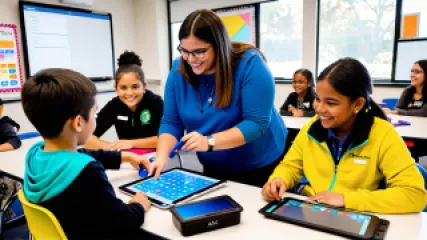Latest Research on Special Education Tools for Enhanced Learning
In recent years, the field of special education has seen significant advancements through research and the development of new tools aimed at enhancing learning for students with diverse needs. These innovations are not only reshaping the way educators approach teaching but also improving the educational experiences of students who require specialized support.
Understanding Special Education
Special education refers to the customized instructional programs designed to meet the unique needs of students with disabilities. These disabilities can range from physical impairments to cognitive challenges, and each student may require a different approach to learning. The goal of special education is to provide these students with opportunities to achieve their highest potential.
The importance of special education cannot be overstated. According to the Individuals with Disabilities Education Act (IDEA), schools are required to provide free and appropriate public education to students with disabilities. This ensures that they receive the same educational opportunities as their peers.
Innovative Tools in Special Education
Recent research has highlighted several innovative tools that have proven effective in special education settings. These tools leverage technology and evidence-based strategies to create more engaging and accessible learning environments. Here are some of the latest advancements:
Assistive Technology
Assistive technology plays a crucial role in helping students with disabilities access the curriculum. Some of the most impactful tools include:
- Communication Devices: Augmentative and Alternative Communication (AAC) devices assist students with speech impairments in expressing themselves. These devices range from simple picture boards to sophisticated speech-generating devices.
- Text-to-Speech Software: This software converts written text into spoken words, aiding students with reading difficulties by allowing them to hear the content.
- Braille Readers: For visually impaired students, Braille readers enable them to read digital text through tactile feedback.
- Adaptive Keyboards: These keyboards are designed with larger keys or alternative layouts to assist students with fine motor difficulties.
Interactive Learning Platforms
Interactive learning platforms are transforming the way special education is delivered. These platforms often include features such as:
- Customizable Lessons: Teachers can tailor lessons to meet the specific needs of each student, providing personalized instruction.
- Gamification: Incorporating game-like elements into learning activities can increase student engagement and motivation.
- Progress Tracking: These platforms allow for real-time monitoring of student progress, enabling timely interventions and support.
Sensory Tools
Sensory tools are designed to help students with sensory processing disorders regulate their sensory input. These tools include:
- Fidget Toys: These small objects can help students focus by providing a physical outlet for excess energy.
- Weighted Blankets: These blankets provide deep pressure stimulation, which can have a calming effect on students with anxiety or sensory sensitivities.
- Sensory Rooms: These dedicated spaces offer a variety of sensory experiences, such as soft lighting, calming sounds, and tactile activities.
Research on Effective Strategies
In addition to technological tools, recent research has identified several effective special education strategies that enhance learning outcomes. These strategies are grounded in evidence-based practices and have been shown to be effective across various disabilities and age groups.
Individualized Education Plans (IEPs)
An Individualized Education Plan (IEP) is a critical component of special education. It outlines the specific goals, accommodations, and services required for each student. Research indicates that well-developed IEPs lead to improved academic and social outcomes. Key elements of an effective IEP include:
- Clear Goals: Setting specific, measurable, achievable, relevant, and time-bound (SMART) goals helps track student progress.
- Regular Reviews: Frequent IEP reviews ensure that the plan remains relevant and adjustments are made as needed.
- Collaboration: Involving parents, teachers, and specialists in the IEP process promotes a holistic approach to the student's education.
Inclusive Education
Inclusive education involves integrating students with disabilities into general education classrooms. Research shows that inclusive settings foster social interaction, reduce stigma, and improve academic performance. Successful inclusion requires:
- Teacher Training: Educators need training in inclusive practices and understanding diverse learning needs.
- Peer Support: Encouraging peer mentorship and cooperative learning activities helps build a supportive classroom environment.
- Accessible Materials: Providing materials in various formats (e.g., audio, visual, tactile) ensures all students can access the curriculum.
Behavioral Interventions
Behavioral interventions are essential for addressing challenging behaviors that may impede learning. Effective strategies include:
- Positive Reinforcement: Rewarding desired behaviors encourages their recurrence.
- Functional Behavior Assessments (FBAs): Conducting FBAs helps identify the underlying causes of challenging behaviors and develop targeted interventions.
- Social Skills Training: Teaching social skills improves interactions and reduces behavioral issues.
The Role of Special Education Advocacy
Advocacy is a vital aspect of special education, ensuring that students receive the services and support they need. Advocates work to protect the rights of students with disabilities and promote equitable access to education.
Parental Advocacy
Parents play a crucial role in advocating for their children's education. Effective parental advocacy involves:
- Understanding Rights: Parents should be familiar with the legal rights and protections afforded to their children under laws like IDEA.
- Active Participation: Being involved in the IEP process and communicating regularly with educators helps ensure that the child's needs are met.
- Seeking Support: Joining special education community groups and seeking guidance from experienced advocates can provide valuable resources and support.
Professional Advocacy
Professional advocates, including lawyers and special education experts, assist families in navigating the complexities of special education. Their services may include:
- IEP Meetings: Advocates can attend IEP meetings to ensure that the student's rights are upheld and that the plan is appropriate.
- Mediation and Due Process: When disputes arise, advocates can represent families in mediation or due process hearings to resolve conflicts.
- Policy Change: Advocates work at the policy level to promote systemic changes that benefit all students with disabilities.
Case Studies: Success Stories in Special Education
Examining real-world examples of successful special education interventions provides valuable insights into best practices. Here are a few case studies that highlight the impact of innovative tools and strategies:
Case Study 1: Using AAC Devices for Communication
Melody Thompson, a speech-language pathologist, worked with a non-verbal student named Alex who had autism. By introducing an AAC device tailored to Alex's needs, Melody observed remarkable improvements in his communication abilities. Alex became more engaged in classroom activities and was able to express his needs and preferences more effectively.
"The AAC device gave Alex a voice he never had before. It transformed his ability to interact with his peers and participate in learning." Melody Thompson
Case Study 2: Inclusive Education in Practice
At Sunshine Elementary School, educators implemented an inclusive education model where students with and without disabilities learned together. With the support of trained teachers and accessible materials, students with disabilities thrived academically and socially. One student, Maya, who has Down syndrome, excelled in her inclusive classroom, building friendships and achieving academic milestones.
"Inclusion has made a world of difference for Maya. She feels part of the community and is learning alongside her peers." Sunshine Elementary Teacher
Case Study 3: Behavioral Interventions for Success
Wilford Cox, a behavior analyst, worked with a student named Liam who exhibited challenging behaviors that disrupted his learning. Through a comprehensive Functional Behavior Assessment (FBA), Wilford identified triggers for Liam's behaviors and developed a positive reinforcement plan. Over time, Liam's behavior improved significantly, allowing him to focus on his studies and engage more positively with classmates.
"Addressing the root causes of Liam's behaviors was key to his success. Positive reinforcement helped him develop better coping strategies." Wilford Cox
Challenges and Future Directions
While there have been significant advancements in special education tools and strategies, challenges remain. Addressing these challenges will require ongoing research, collaboration, and innovation.
Access and Equity
Ensuring equitable access to special education tools and services is a major challenge. Students in underserved communities often face barriers to obtaining the resources they need. Efforts to bridge this gap include:
- Funding: Advocating for increased funding for special education programs to ensure all students have access to necessary tools and support.
- Outreach: Providing information and resources to families in underserved areas to help them navigate the special education system.
- Partnerships: Collaborating with community organizations to deliver services and support to students in need.
Training and Professional Development
Educators and specialists require ongoing training to stay current with the latest research and tools in special education. Effective professional development includes:
- Workshops and Conferences: Attending events where experts share new findings and best practices.
- Online Courses: Leveraging digital platforms to access training on-demand.
- Mentorship Programs: Pairing experienced educators with new teachers to provide guidance and support.
Technology Integration
Integrating technology into special education poses both opportunities and challenges. Ensuring that technology is used effectively requires:
- Accessibility: Designing tools that are accessible to all students, regardless of their disability.
- Training: Providing educators with training on how to use technology effectively in the classroom.
- Evaluation: Continuously evaluating the impact of technology on student outcomes to make informed decisions about its use.
Conclusion: Embracing Innovation for Enhanced Learning
The latest research on special education tools underscores the transformative potential of innovative strategies and technologies in enhancing learning for students with disabilities. From assistive technology to inclusive education models, these advancements are making a significant impact on the educational experiences of students who require specialized support.
However, the journey is far from over. Addressing challenges related to access, equity, and training will be essential in ensuring that all students benefit from these advancements. By continuing to advocate for the rights of students with disabilities and embracing a collaborative approach, educators, researchers, and families can work together to create a more inclusive and supportive educational landscape.
Ultimately, the goal of special education is to provide every student with the opportunity to reach their full potential. Through the continued development and implementation of effective tools and strategies, we can move closer to achieving this vision, ensuring that no student is left behind.
Thank you for taking the time to explore the latest research on special education tools for enhanced learning. We hope this summary has provided valuable insights and inspiration for your own educational practices and advocacy efforts.






